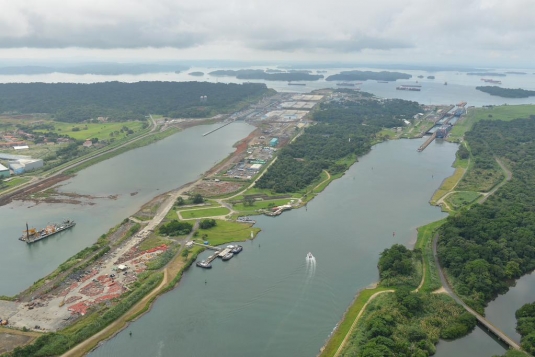After averting a major labor dispute in mid-August, the Panama Canal expansion project seemed to be moving forward. Unfortunately for the project and the Panamanian people, there is a myriad of issues that could hinder the canal’s ability to meet the planned April 2016 opening. The expansion project was originally scheduled to coincide with the 100-year anniversary of the existing Canal in 2014, and its scope was intended to make it equipped to handle a new generation of ultra-large container ships. As a result of cost overruns and delays, the completion of this massive undertaking was pushed to April 2016.
Today, the project faces continued financial dilemmas; tugboat safety issues; reduced capacity; and recently discovered leaks in elements of the new construction, causing more concern for the project meeting the April expansion launch deadline. With the project already behind its original launch date, the opening of a newly expanded Panama Canal could be delayed further after the discovery of leaks in the new locks. The construction of the new locks is the central component of the $5.25 billion expansion program, and the Panama Canal Authority (PCA) stated that it would not sacrifice the quality of the work on done on the cracks to meet the deadline.
Project engineers from the Grupo Unidos por el Canal (GUPC) are already implementing solutions for the leaks and cracks in the locks, but there is some skepticism from officials at the PCA that these corrections will keep the project on track. Currently, the PCA is not changing the time frame for opening the Canal until more of the corrections have been completed. Until then, the PCA’s determination for the project’s completion relies solely on the word of the contractors, who believe the leaks will not delay the development.
The GUPC is a building consortium comprised of Spain’s Sacyr Vallehermoso, Italy’s Impregilo, Belgium’s Jan De Nul and Panama’s Constructura Urbana, SA. and is handling the construction of the locks. Conflicts and mistrust between the PCA and GUPC only add to the rising construction costs. These continued disputes and delays between the two entities have put the project $200 million over budget, forcing the PCA to seek an additional $450 million from the United States and Europe to help finance the project.
Adding to the Canal’s dilemmas are new concerns from the International Transport Workers’ Federation (ITF) over tugboat safety, calling for fundamental changes to Canal operations. The ITF commissioned a study to address growing concerns about serious deficiencies in the tugboat fleet set to navigate ships through the new locks. Many Panama Canal tugboat pilots feel the new system is less safe in contrast to the current locomotive method used by the canal because they will need to maneuver bigger ships through larger locks. The study will analyze the maneuverability considerations for safe transit through the locks and hopefully, also provide new safety procedures for seafarers and Panama Canal workers.
Meanwhile, as the PCA deals with these issues, the canal is operating at reduced capacity due to the planned maintenance of existing locks. This service is unrelated to the leaks at key elements of the Canal’s current expansion and has dropped the canal’s capacity by 50%. The scheduled maintenance has closed locks selectively for servicing, causing severe delays in operations of the ships passing through the Canal. According to PCA, some vessels have even been delayed by up to a week. The canal should feel some relief from the delays this month as planned repairs are completed.
Despite all the issues surrounding the expansion, Panama is already benefiting from the project. While the addition of the new locks prepares the canal for the next generation of mega-sized container ships by effectively doubling its capacity, the expansion has also created new market segments for the canal like liquefied natural gas. After a national referendum had approved this project in 2006, Panama’s gross domestic product grew from $15 billion to almost $50 billion with a 4% unemployment rate and inflation below 2.6%. The end of this fiscal year also proved to be prosperous for the Panama Canal as the volume represented increased by 4.3% from 2014, setting a new historical tonnage record after 340.8 million tons passed through the waterway.


